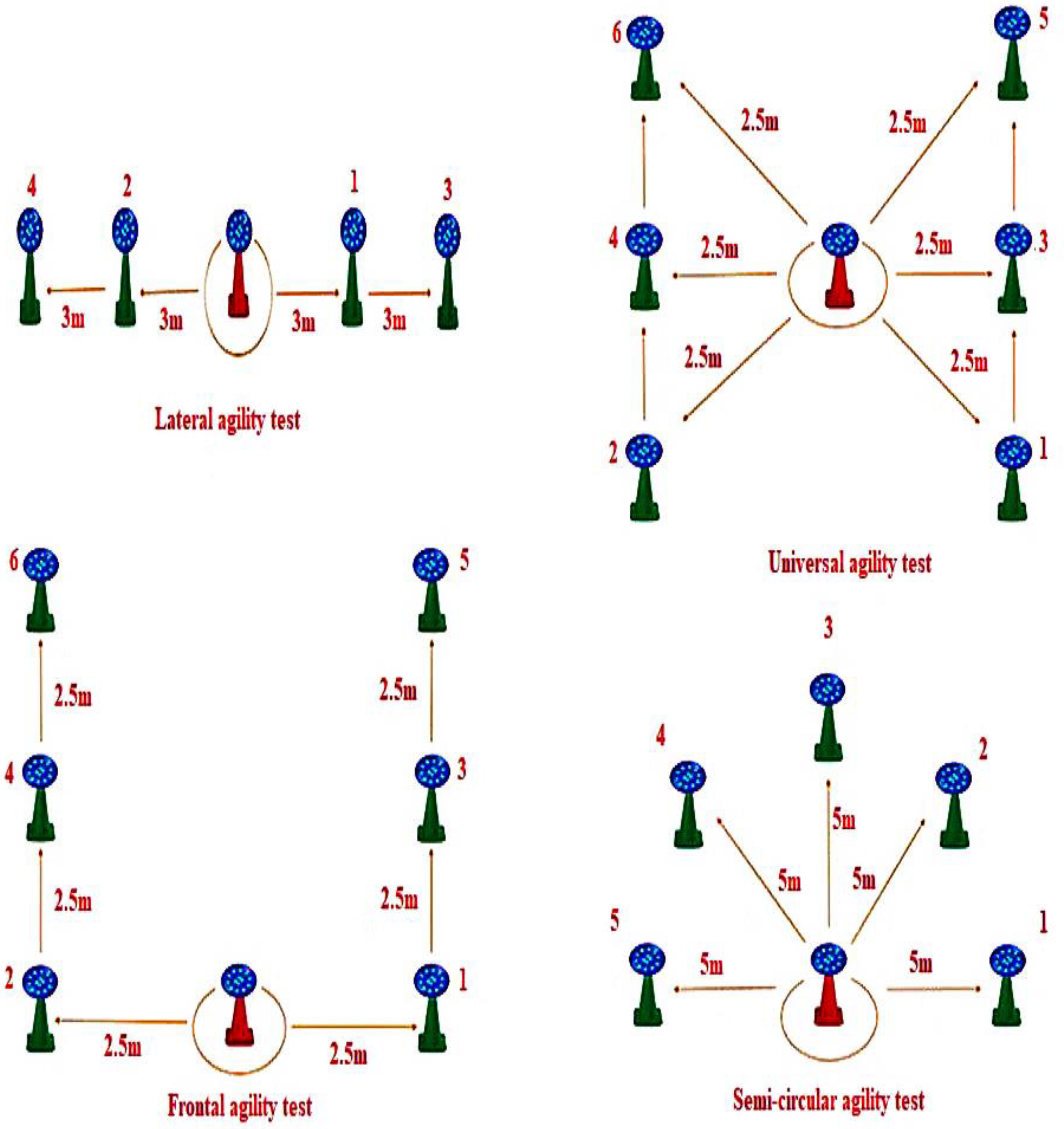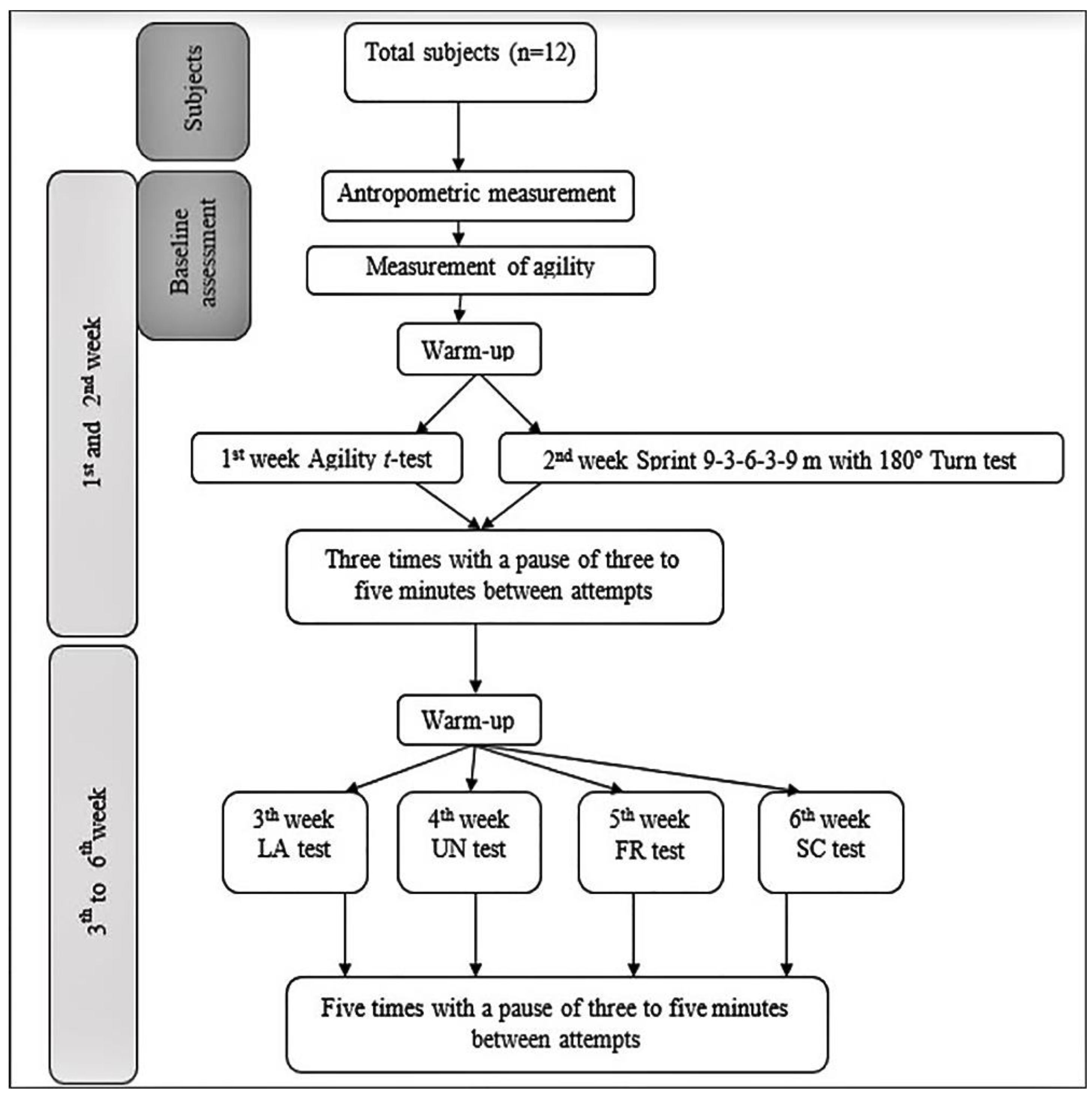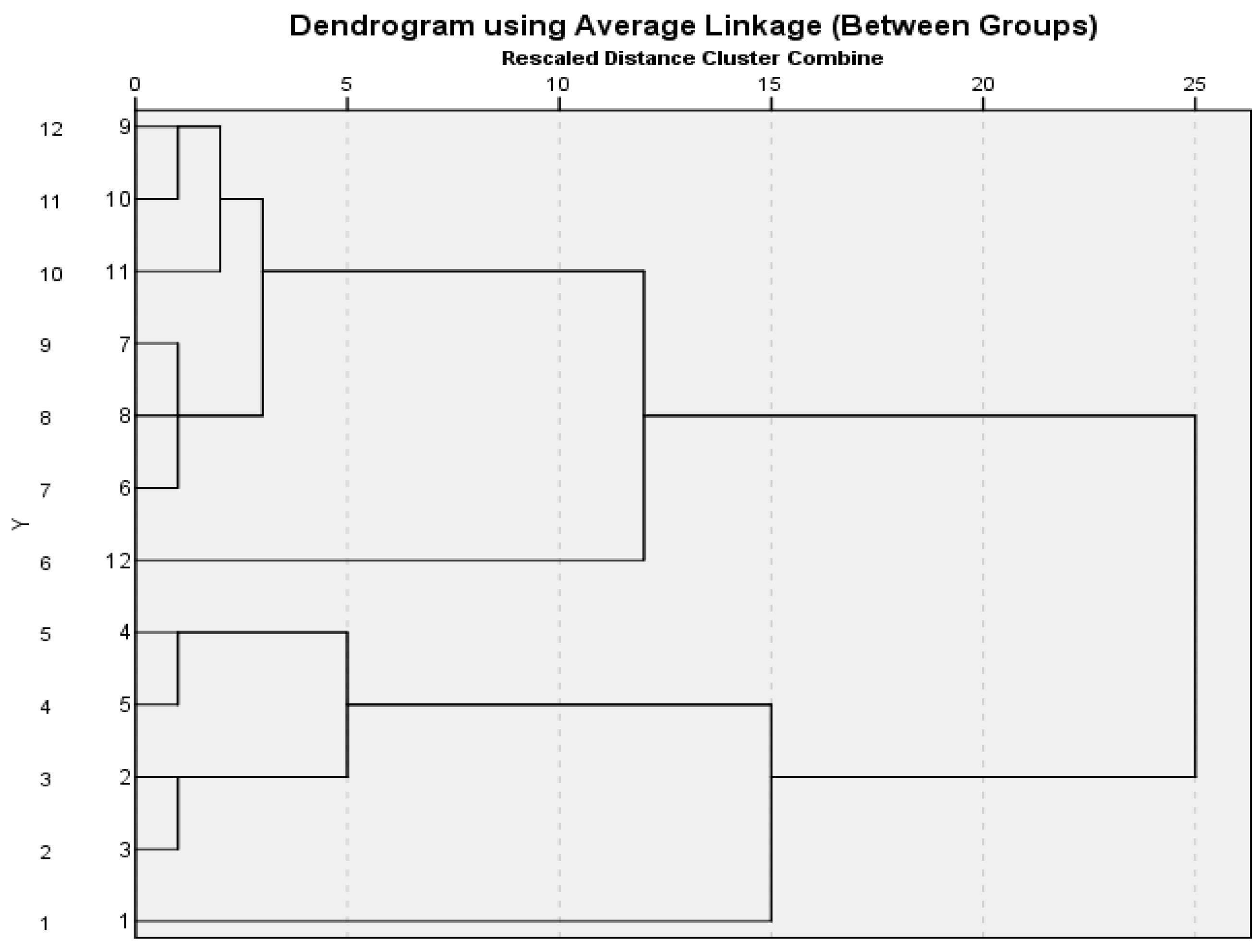Innovative Protocols for Determining the Non-Reactive Agility of Female Basketball Players Based on Familiarization and Validity Tests
Abstract
1. Introduction
2. Materials and Methods
2.1. Research Protocol
- Participants did not have any chronic disease and did not consume medications as a prescribed therapy in order to cure any kind of illness;
- Participants of this research were not in their menstrual period;
- Participants did not eat or drink 8 h before the test (no food or drink from 00:00 to 08:00);
- Participants emptied their bladder before the testing;
- Participants due to the needs of the testing, were barefoot and wore only their bathing suits.
2.2. Subjects
2.3. Procedures
2.3.1. The Protocol of Familiarization with Agility Tests
2.3.2. Construct Validity Testing
2.4. Statistical Analysis
3. Results
3.1. The Familiarization Protocol
3.2. Validation
4. Discussion
5. Conclusions and Practical Applications
Author Contributions
Funding
Institutional Review Board Statement
Informed Consent Statement
Data Availability Statement
Acknowledgments
Conflicts of Interest
References
- Coh, M.; Vodicar, J.; Žvan, M.; Šimenko, J.; Stodolka, J.; Rauter, S.; Mackala, K. Are change-of-direction speed and reactive agility independent skills even when using the same movement pattern? J. Strength Cond. Res. 2018, 32, 1929–1936. [Google Scholar] [CrossRef] [PubMed]
- Castagna, C.; Chaouachi, A.; Rampinini, E.; Chamari, K.; Impellizzeri, F. Aerobic and explosive power performance of elite Italian regional-level basketball players. J. Strength Cond. Res. 2009, 23, 1982–1987. [Google Scholar] [CrossRef] [PubMed]
- Mankowska, M.; Poliszczuk, T.; Poliszczuk, D.; Johne, M. Visual perception and its effect on reaction time and time-movement anticipation in elite female basketball players. Pol. J. Sport Tour. 2015, 22, 3–8. [Google Scholar] [CrossRef]
- Bavli, Ö. Investigation into the effects of eight weeks of step aerobic dance practice on static balance, flexibility and selected basketball skills in young basketball players. J. Educ. Train. Stud. 2016, 4, 233–238. [Google Scholar] [CrossRef]
- Jakovljevic, S.T.; Karalejic, M.S.; Pajic, Z.B.; Macura, M.M.; Erculj, F.F. Speed and agility of 12-and 14-year-old elite male basketball players. J. Strength Cond. Res. 2012, 26, 2453–2459. [Google Scholar] [CrossRef]
- Hachana, Y.; Chaabène, H.; Ben Rajeb, G.; Khlifa, R.; Aouadi, R.; Chamari, K.; Gabbett, T.J. Validity and reliability of new agility test among elite and subelite under 14-soccer players. PLoS ONE 2014, 9, e95773. [Google Scholar] [CrossRef]
- Lockie, R.G.; Jeffriess, M.D.; McGann, T.S.; Callaghan, S.J.; Schultz, A.B. Planned and reactive agility performance in semiprofessional and amateur basketball players. Int. J. Sports Physiol. Perform. 2014, 9, 766–771. [Google Scholar] [CrossRef]
- Spasic, M.; Krolo, A.; Zenic, N.; Delextrat, A.; Sekulic, D. Reactive agility performance in handball; development and evaluation of a sport-specific measurement protocol. J. Sports Sci. Med. 2015, 14, 501–506. [Google Scholar]
- Conte, D.; Favero, T.G.; Lupo, C.; Francioni, F.M.; Capranica, L.; Tessitore, A. Time-motion analysis of Italian elite women’s basketball games: Individual and team analyses. J. Strength Cond. Res. 2015, 29, 144–150. [Google Scholar] [CrossRef]
- Matthew, D.; Delextrat, A. Heart rate, blood lactate concentration, and time–motion analysis of female basketball players during competition. J. Sports Sci. 2009, 27, 813–821. [Google Scholar] [CrossRef]
- Mackala, K.; Vodičar, J.; Žvan, M.; Križaj, J.; Stodolka, J.; Rauter, S.; Čoh, M. Evaluation of the pre-planned and non-planed agility performance: Comparison between individual and team sports. Int. J. Environ. Res. Public Health 2020, 17, 975. [Google Scholar] [CrossRef]
- Čoh, M. Reactive (pre-planned) and non-reactive (non-planned) agility in diagnosis of athletes. Phys. Educ. Sport Centuries 2019, 6, 95–106. [Google Scholar] [CrossRef]
- Sheppard, J.M.; Young, W.B.; Doyle, T.L.A.; Sheppard, T.A.; Newton, R.U. An evaluation of a new test of reactive agility and its relationship to sprint speed and change of direction speed. J. Sci. Med. Sport 2006, 9, 342–349. [Google Scholar] [CrossRef]
- Young, W.B.; Willey, B. Analysis of a reactive agility field test. J. Sci. Med. Sport 2010, 13, 376–378. [Google Scholar] [CrossRef]
- McLester, C.N.; Nickerson, B.S.; Kliszczewicz, B.M.; McLester, J.R. Reliability and agreement of various InBody body composition analyzers as compared to dual-energy X-ray absorptiometry in healthy men and women. J. Clin. Densitom. 2020, 23, 443–450. [Google Scholar] [CrossRef]
- Nikolaidis, P.T.; Asadi, A.; Santos, E.J.; Calleja-González, J.; Padulo, J.; Chtourou, H.; Zemkova, E. Relationship of body mass status with running and jumping performances in young basketball players. Muscles Ligaments Tendons J. 2015, 5, 187–194. [Google Scholar] [CrossRef]
- World Medical Association. Handbook of WMA Policies. 2011. Available online: http://www.wma.net/en/30publications/10policies/b3/index.html (accessed on 15 November 2012).
- Young, W.B.; Miller, I.R.; Talpey, S.W. Physical qualities predict change-of-direction speed but not defensive agility in Australian rules football. J. Strength Cond. Res. 2015, 29, 206–212. [Google Scholar] [CrossRef]
- Pauole, K.; Madole, K.; Garhammer, J.; Lacourse, M.; Rozenek, R. Reliability and validity of the t-test as a measure of agility, leg power, and leg speed in college-aged men and women. J. Strength Cond. Res. 2000, 14, 443–450. [Google Scholar]
- Sporis, G.; Jukic, I.; Milanovic, L.; Vucetic, V. Reliability and factorial validity of agility tests for soccer players. J. Strength Cond. Res. 2010, 24, 679–686. [Google Scholar] [CrossRef]
- Akoglu, H. User’s guide to correlation coefficients. Turk. J. Emerg. Med. 2018, 18, 91–93. [Google Scholar] [CrossRef]
- Kuznetsov, A.; Kuznetsova, Z.; Mutaeva, I. Diagnostics of functional state and reserve capacity of young athletes’ organism. In Proceedings of the 5th International Congress on Sport Sciences Research and Technology Support, Madeira, Portugal, 30–31 October 2017; pp. 111–114. [Google Scholar]
- Sekulic, D.; Krolo, A.; Spasic, M.; Uljevic, O.; Peric, M. The development of a New Stop’n’go reactive-agility test. J. Strength Cond. Res. 2014, 28, 3306–3312. [Google Scholar] [CrossRef] [PubMed]
- Vrbik, I.; Sporiš, G.; Štefan, L.; Madić, D.; Trajković, N.; Valantine, I.; Milanović, Z. The influence of familiarization on physical fitness test results in primary school-aged children. Pediatr. Exerc. Sci. 2017, 29, 278–284. [Google Scholar] [CrossRef] [PubMed]
- Coledam, D.H.C.; de Oliveira, R.D.C. Assessment of physical fitness among non-athlete adolescents: Effect of familiarization sessions. Balt. J. Health Phys. Act. 2020, 12, 47–57. [Google Scholar] [CrossRef]
- Gray, H.N.; Williams, R.M.; Valovich McLeod, T.C.; Bay, R.C. Establishing reliability of a reaction time testing battery in high school athletes. Athl. Train. Sports Health Care 2021, 13, 168–175. [Google Scholar] [CrossRef]
- Tomac, Z.; Hraski, Z.; Sporis, G. The assessment of preschool children’s motor skills after familiarization with motor tests. J. Strength Cond. Res. 2012, 26, 1792–1798. [Google Scholar] [CrossRef]
- Hopkins, W.G. Measures of reliability in sports medicine and science. Sports Med. 2000, 30, 1–15. [Google Scholar] [CrossRef]
- Taktek, K.; Zinsser, N.; St-John, B. Visual versus kinaesthetic mental imagery: Efficacy for the retention and transfer of a closed motor skill in young children. Can. J. Exp. Psychol. 2008, 62, 174–187. [Google Scholar] [CrossRef]
- Tomac, Z.; Hraski, Z. Influence of familiarization of preschool children with motor tests on test results and reliability coefficients. Percept. Mot. Skills 2016, 123, 717–736. [Google Scholar] [CrossRef]
- Krolo, A.; Gilic, B.; Foretic, N.; Pojskic, H.; Hammami, R.; Spasic, M.; Uljevic, O.; Versic, S.; Sekulic, D. Agility testing in youth football (soccer) players; evaluating reliability, validity, and correlates of newly developed testing protocols. Int. J. Environ. Res. Public Health 2020, 17, 294. [Google Scholar] [CrossRef]
- Scanlan, A.T.; Dascombe, B.J.; Reaburn, P.R. The construct and longitudinal validity of the basketball exercise simulation test. J. Strength Cond. Res. 2012, 26, 523–530. [Google Scholar] [CrossRef]
- Gonzalo-Skok, O.; Tous-Fajardo, J.; Suarez-Arrones, L.; Arjol-Serrano, J.L.; Casajus, J.A.; Mendez-Villanueva, A. Validity of the V-cut test for young basketball players. Int. J. Sports Med. 2015, 94, 893–899. [Google Scholar] [CrossRef]
- Schwesig, R.; Hermassi, S.; Lauenroth, A.; Laudner, K.; Koke, A.; Bartels, T.; Delank, S.; Schulze, S. Validity of a basketball-specific complex test in female professional players. Sportverletz. Sportschaden 2018, 32, 125–133. [Google Scholar] [CrossRef]
- Stojanovic, E.; Aksovic, N.; Stojiljkovic, N.; Stankovic, R.; Scanlan, A.T.; Milanovic, Z. Reliability, usefulness, and factorial validity of change-of-direction speed tests in adolescent basketball players. J. Strength Cond. Res. 2019, 33, 3162–3173. [Google Scholar] [CrossRef]
- Conte, D.; Smith, M.R.; Santolamazza, F.; Favero, T.G.; Tessitore, A.; Coutts, A. Reliability, usefulness and construct validity of the combined basketball skill test (CBST). J. Sports Sci. 2019, 37, 1205–1211. [Google Scholar] [CrossRef]
- Brini, S.; Boullosa, D.; Calleja-González, J.; Delextrat, A. Construct validity and reliability of a new basketball multidirectional reactive repeated sprint test. Int. J. Environ. Res. Public Health 2021, 18, 10695. [Google Scholar] [CrossRef]
- Dinh, D.T.; Fujinami, T.; Huynh, V.N. Estimating the optimal number of clusters in categorical data clustering by silhouette coefficient. In Proceedings of the Knowledge and Systems Sciences: 20th International Symposium, KSS 2019, Da Nang, Vietnam, 29 November–1 December 2019; pp. 1–17. [Google Scholar]
- Delextrat, A.; Cohen, D. Strength, power, speed, and agility of women basketball players according to playing position. J. Strength Cond. Res. 2009, 23, 1974–1981. [Google Scholar] [CrossRef]
- Mielgo-Ayuso, J.; Calleja-González, J.; Clemente-Suárez, V.J.; Zourdos, M.C. Influence of anthropometric profile on physical performance in elite female volleyballers in relation to playing position. Nutr. Hosp. 2015, 31, 849–857. [Google Scholar]
- Fort-Vanmeerhaeghe, A.; Montalvo, A.; Latinjak, A.; Unnithan, V. Physical characteristics of elite adolescent female basketball players and their relationship to match performance. J. Hum. Kinet. 2016, 53, 167–178. [Google Scholar] [CrossRef]
- Boichuk, R.; Iermakov, S.; Vintoniak, O.; Yermakova, T. Combined impact method in the preparatory period of the annual macrocycle of female volleyball players aged 18–19 years old. Pedagog. Phys. Cult. Sports 2021, 25, 234–243. [Google Scholar] [CrossRef]
- McCormick, B.T.; Hannon, J.C.; Newton, M.; Shultz, B.; Detling, N.; Young, W.B. The effects of frontal-and sagittal-plane plyometrics on change-of-direction speed and power in adolescent female basketball players. Int. J. Sports Physiol. Perform. 2016, 11, 102–107. [Google Scholar] [CrossRef]
- Spiteri, T.; Newton, R.U.; Binetti, M.; Hart, N.H.; Sheppard, J.M.; Nimphius, S. Mechanical determinants of faster change of direction and agility performance in female basketball athletes. J. Strength Cond. Res. 2015, 29, 2205–2214. [Google Scholar] [CrossRef] [PubMed]
- Sheppard, J.M.; Young, W.B. Agility literature review: Classifications, training and testing. J. Sports Sci. 2006, 24, 919–932. [Google Scholar] [CrossRef] [PubMed]



| Notation | Definition |
|---|---|
| HPA | High performance agility group |
| LPA | Low performance agility group |
| LA | Lateral agility test |
| UA | Universal agility test |
| FR | Frontal agility test |
| SC | Semicircular agility test |
| NTA | FR Mean ± SD | LA Mean ± SD | SC Mean ± SD | UN Mean ± SD |
|---|---|---|---|---|
| I | 15.336 ± 1.030 | 10.703 ± 0.387 | 16.246 ± 0.875 | 12.888 ± 0.720 |
| II | 14.966 ± 0.761 | 10.694 ± 0.589 | 16.010 ± 1.110 | 12.887 ± 0.356 |
| III | 14.514 ± 0.913 | 10.578 ± 0.507 | 16.045 ± 1.076 | 12.267 ± 0.657 |
| IV | 15.203 ± 1.308 | 10.438 ± 0.502 | 16.023 ± 1.003 | 12.647 ± 1.224 |
| V | 15.141 ± 1.501 | 10.232 ± 0.477 | 15.695 ± 0.854 | 12.318 ± 1.033 |
| Test | Wilks’s Lambda | F | Sig. | Partial Eta Squared | Mauchly’s Test of Sphericity (Sig.) | ANOVA (Sig.) | |||
|---|---|---|---|---|---|---|---|---|---|
| FR | 0.278 | 5.206 | 0.023 | 0.722 | 0.258 | I–III (0.016) | |||
| LA | 0.169 | 9.844 | 0.004 | 0.831 | 0.113 | I–V (0.002) | II–IV (0.018) | II–V (0.002) | III–V (0.001) |
| SC | 0.188 | 8.664 | 0.005 | 0.812 | 0.001 | I–V (0.015) | |||
| UN | 0.230 | 6.567 | 0.012 | 0.770 | 0.009 | I–III (0.022) | |||
| Variables | Group | Kolmogorov–Smirnov | ||
|---|---|---|---|---|
| Statistic | df | Sig. | ||
| Agility t-test | HPA | 0.263 | 5 | 0.200 |
| LPA | 0.193 | 7 | 0.200 | |
| 9-3-6-3-9 | HPA | 0.203 | 5 | 0.200 |
| LPA | 0.229 | 7 | 0.200 | |
| FR | HPA | 0.332 | 5 | 0.075 |
| LPA | 0.223 | 7 | 0.200 | |
| UN | HPA | 0.278 | 5 | 0.200 |
| LPA | 0.220 | 7 | 0.200 | |
| LA | HPA | 0.170 | 5 | 0.200 |
| LPA | 0.218 | 7 | 0.200 | |
| SC | HPA | 0.240 | 5 | 0.200 |
| LPA | 0.126 | 7 | 0.200 | |
| Variables | HPA (Mean ± SD) | LPA (Mean ± SD) | Sig. |
|---|---|---|---|
| FR | 13.706 ± 0.636 | 14.834 ± 0.475 | 0.005 |
| UN | 11.526 ± 0.549 | 12.440 ± 0.296 | 0.004 |
| LA | 9.782 ± 0.353 | 10.531 ± 0.244 | 0.001 |
| SC | 14.844 ± 0.657 | 16.164 ± 0.471 | 0.002 |
| Variables | Agility t-Test | 9-3-6-3-9 | FR | UN | LA | SC | |
|---|---|---|---|---|---|---|---|
| Agility t-test | Pearson’s Correlation | 1 | 0.970 ** | 0.948 ** | 0.936 ** | 0.969 ** | 0.973 ** |
| Sig. (2-tailed) | 0.000 | 0.000 | 0.000 | 0.000 | 0.000 | ||
| 9-3-6-3-9 | Pearson’s Correlation | 0.970 ** | 1 | 0.956 ** | 0.962 ** | 0.987 ** | 0.982 ** |
| Sig. (2-tailed) | 0.000 | 0.000 | 0.000 | 0.000 | 0.000 | ||
| FR | Pearson’s Correlation | 0.948 ** | 0.956 ** | 1 | 0.983 ** | 0.949 ** | 0.985 ** |
| Sig. (2-tailed) | 0.000 | 0.000 | 0.000 | 0.000 | 0.000 | ||
| UN | Pearson’s Correlation | 0.936 ** | 0.962 ** | 0.983 ** | 1 | 0.958 ** | 0.987 ** |
| Sig. (2-tailed) | 0.000 | 0.000 | 0.000 | 0.000 | 0.000 | ||
| LA | Pearson’s Correlation | 0.969 ** | 0.987 ** | 0.949 ** | 0.958 ** | 1 | 0.977 ** |
| Sig. (2-tailed) | 0.000 | 0.000 | 0.000 | 0.000 | 0.000 | ||
| SC | Pearson’s Correlation | 0.973 ** | 0.982 ** | 0.985 ** | 0.987 ** | 0.977 ** | 1 |
| Sig. (2-tailed) | 0.000 | 0.000 | 0.000 | 0.000 | 0.000 | ||
| Discriminant Analysis | ||||||||
|---|---|---|---|---|---|---|---|---|
| Eigenvalue | Canonical Correlation | Wilks’s Lambda | Chi-Square | Sig. | LA | SC | UN | FR |
| 2.072 | 0.821 | 0.326 | 8.978 | 0.062 | 0.961 | 0.895 | 0.825 | 0.777 |
| Reliability | Kendall’s Coefficient of Concordance | |
|---|---|---|
| Cronbach’s Alpha | W | Sig. |
| 0.981 | 1 | 0.000 |
Disclaimer/Publisher’s Note: The statements, opinions and data contained in all publications are solely those of the individual author(s) and contributor(s) and not of MDPI and/or the editor(s). MDPI and/or the editor(s) disclaim responsibility for any injury to people or property resulting from any ideas, methods, instructions or products referred to in the content. |
© 2023 by the authors. Licensee MDPI, Basel, Switzerland. This article is an open access article distributed under the terms and conditions of the Creative Commons Attribution (CC BY) license (https://creativecommons.org/licenses/by/4.0/).
Share and Cite
Hadžović, M.M.; Đorđević, S.N.; Jorgić, B.M.; Stojiljković, N.Đ.; Olanescu, M.A.; Suciu, A.; Peris, M.; Plesa, A. Innovative Protocols for Determining the Non-Reactive Agility of Female Basketball Players Based on Familiarization and Validity Tests. Appl. Sci. 2023, 13, 6023. https://doi.org/10.3390/app13106023
Hadžović MM, Đorđević SN, Jorgić BM, Stojiljković NĐ, Olanescu MA, Suciu A, Peris M, Plesa A. Innovative Protocols for Determining the Non-Reactive Agility of Female Basketball Players Based on Familiarization and Validity Tests. Applied Sciences. 2023; 13(10):6023. https://doi.org/10.3390/app13106023
Chicago/Turabian StyleHadžović, Miljan M., Stefan N. Đorđević, Bojan M. Jorgić, Nenad Đ. Stojiljković, Mihai A. Olanescu, Adrian Suciu, Miruna Peris, and Alin Plesa. 2023. "Innovative Protocols for Determining the Non-Reactive Agility of Female Basketball Players Based on Familiarization and Validity Tests" Applied Sciences 13, no. 10: 6023. https://doi.org/10.3390/app13106023
APA StyleHadžović, M. M., Đorđević, S. N., Jorgić, B. M., Stojiljković, N. Đ., Olanescu, M. A., Suciu, A., Peris, M., & Plesa, A. (2023). Innovative Protocols for Determining the Non-Reactive Agility of Female Basketball Players Based on Familiarization and Validity Tests. Applied Sciences, 13(10), 6023. https://doi.org/10.3390/app13106023









